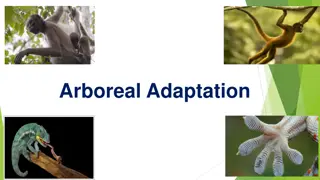Arboreal Adaptation of Chameleons
Chameleons, known for their arboreal lifestyle, possess unique adaptations for tree-dwelling, such as specialized feet for gripping branches and a long tail for balance. Their ability to change body color, protrusible tongue for catching prey, and sharp claws further enhance their survival in arboreal habitats.
Download Presentation

Please find below an Image/Link to download the presentation.
The content on the website is provided AS IS for your information and personal use only. It may not be sold, licensed, or shared on other websites without obtaining consent from the author. Download presentation by click this link. If you encounter any issues during the download, it is possible that the publisher has removed the file from their server.
E N D
Presentation Transcript
Arboreal Adaptation of animals
Chamaeleon Kingdom: Animalia Phylum: Chordata Class: Reptilia Order: Squamata Suborder: Iguania Clade: Acrodonta Family: Chamaeleonid ae
Chamaeleon Chameleons are arboreal, meaning they spend the majority of their time up in the trees. They are perfectly adapted to this lifestyle.
Chameleons feet split at nearly a 180 degree angle allowing for a superior grip on the branches where they live. Another great climbing adaptation is the tail. It is very long and used to balance the body during locomotion.
Chameleon Chameleon, (family Chamaeleonidae), any of a group of primarily arboreal (tree-dwelling) Old World lizards best known for their ability to change body colour. Other characteristics of chameleons include zygodactylous feet (with toes fused into opposed bundles of two and three), acrodont dentition (with the teeth attached to the edge of the jaw), eyes that move independently, atrophied venom glands that produce harmless trace amounts of venom, and a long, slender projectile tongue.
Contd. Protrusible tongue Long protrusible tongue makes them easy to catch the prey. Changeable body colour Can change their body colour. Protect the animals to hide from the enemies. Phenomenon is called mimicry.
Claws Digits are with sharp and well developed claws.Help the animal in walking and climbing on branches of tree and other vertical surfaces. Presence of neck Neck helps to locate preys and enemies as it provides mobility to the head which enhances the efficiency of eyes.
Both forelimbs and hind limbs well developed. The claws are zygodactylus in which digits are found in groups. The toes are opposed (2 versus 3) for grasping branches of trees.
Hyla Kingdom: Animalia Phylum: Chordata Class: Amphibia Order: Anura Family: Hylidae Subfamily: Hylinae Genus: Hyla
Hyla Green treefrogs are frequently found in small ponds, large lakes, marshes, and streams. They prefer habitats with plentiful floating vegetation, grasses. Hyla is commonly distributed in India, China, United States, Africa and Canada. Habit and habitat : Hyla is arboreal in habit, living on trees and rocks.
Forelimbs and hind limbs adapted for arboreal life. Terminal base of each digit is claw shaped and toes contain expanded adhesive discs or cushions which are used to climb trees.
Skin of belly contains hygroscopic glands which help in adhering the frog with leaf, twigs or stem.
They also change their colour according to their environment and show camouflage or mimicry. Hyla faber shows peculiar parental care. It comes down from the tree. Females dig up mud of shallow pond, make small nurseries, and eggs are laid in them. The larvae hatch and go into submerged water.
Preshytis Kingdom: Animalia Phylum: Chordata Class: Mammalia Order: Primates Suborder: Haplorhini Infraorder: Simiiformes Family: Cercopithecida e Subfamily: Colobinae Genus: Presbytis
Preshytis The surilis are a group of Old World monkeys and make up the entirety of the genus Presbytis. They live in the Thai-Malay Peninsula, on Sumatra, Borneo, Java and smaller nearby islands. Besides surili, the common names for the monkeys in the genus also sometimes use the terms "langur" or "leaf monkey." Surilis are rather small, slimly built primates. Diurnal forest dwellers, they spend nearly their entire lives in the trees.
i) Strong chest and ribs They have strong chest, ribs and limb girdles. Thorax is sub-circular in shape and the ribs have greater curvature. ii)Strong girdle bones Pelvic and pectoral girdles are strong to support the body weight during climbing and hanging. Ilium of pelvic girdle is very broad and it serves to support the viscera. iii)Grasping type of feet

























